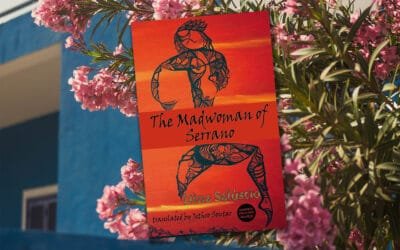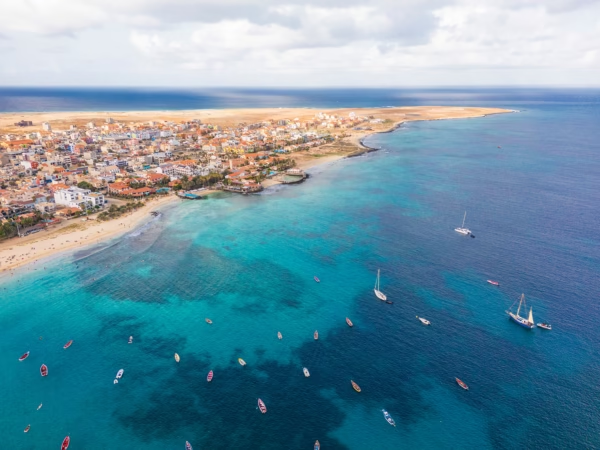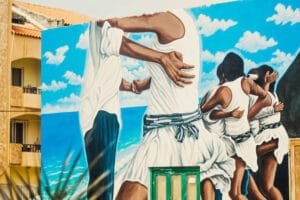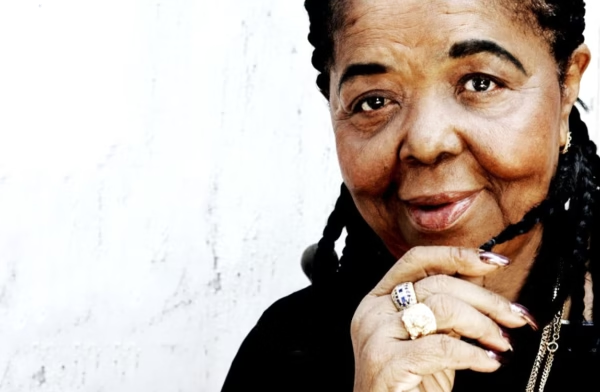Morna: the Beautiful Sodade in Cape Verdean Music
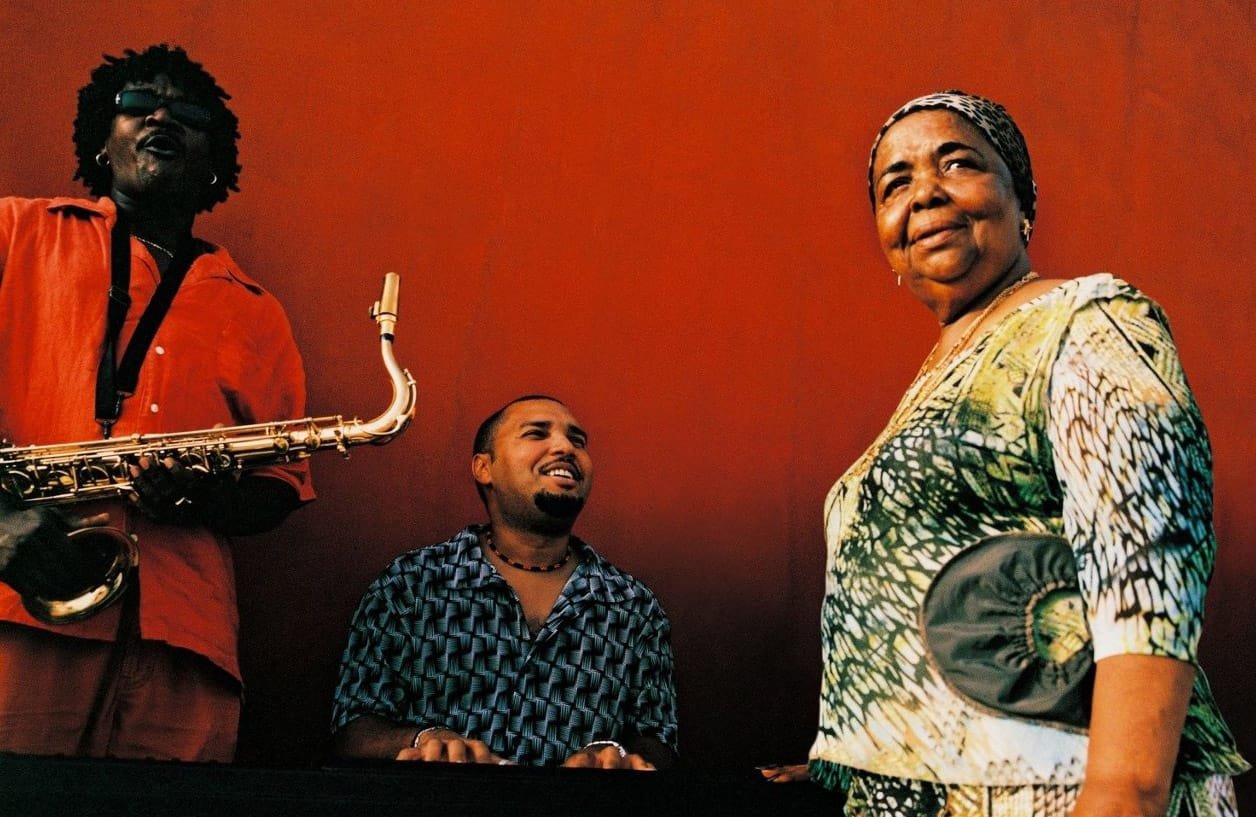
On a balmy evening on the Cape Verdean island of São Vicente. The gentle strum of a guitar and the plaintive voice of a singer spill out from a seaside tavern. Inside, couples sway in a close embrace, moving slowly to the languid rhythm of a morna. A song of love and longing seems to carry on the ocean breeze. Eyes glisten with emotion as the lyrics speak of sodade. A deep nostalgia for faraway loved ones and the homeland. Scenes like this have played out for generations in Cabo Verde, where no music captures the spirit of the islands more than this one.
Morna
Morna performances are often intimate. Vocalists are accompanied by guitars, violins, and other string instruments, creating a heartfelt atmosphere. Morna is Cabo Verde’s national music genre. It’s a traditional style that blends voice, instrumental melody, poetic lyrics, and even elements of dance. Characterised by a slow, flowing tempo and soulful songs, it’s the emotional heartbeat of Cape Verdean culture. Morna’s heard at both joyous and solemn occasions: weddings, christenings, family gatherings, or informal evenings among friends. Often compared to Portugal’s fado and Brazil’s modinha for its bittersweet style, it’s an original Cape Verdean music and a potent symbol of the Cape Verdean identity.
Origins of morna
Cabo Verde’s unique history set the stage for the birth of its unique music genre. The archipelago, uninhabited until the 15th century, became a crossroads of the Atlantic slave trade after Portuguese colonisers established a presence. Enslaved Africans were brought to the islands, and over time, a creole society emerged, blending African and European peoples and traditions. Out of this crucible of suffering and cultural fusion, morna gradually took shape. Oral tradition holds that the earliest morna songs originated on the island of Boa Vista in the late 1700s. Although there is no written record, the exact origins remain unclear. In those early days, it is said that cantadeiras – women singers, often enslaved – would improvise morna verses about daily life, using music as both an emotional outlet and a form of satire or social commentary. Their songs provided comfort in hardship and gave a voice to the voiceless.
Early Development
The music of early morna wove together influences from several continents. Scholars trace its roots to an Afro-Brazilian rhythm and dance called lundu (or landú in Creole) that would have arrived with enslaved people or Cape Verdean sailors returning from Brazil. To this African base were added the melodic sensibilities of Portuguese folk music and perhaps the “sweet lament” of the Brazilian modinha ballad. The first proto-morna tunes on Boa Vista were reportedly quicker and more rustic than the morna of today. One early song known as “Babylon,” attributed to a woman from Boa Vista in the mid-19th century, was said to have a lively tempo and playful tone. By the late 1800s, the genre had begun to mature. Unlike other local dances that later absorbed European polkas and waltzes, morna retained its distinct character throughout the 19th century. Musicologists cite a morna called “Brada Maria,” composed around 1870, as one of the oldest known examples of the style. It’s evidence that by that time, morna was already an integral part of island life.
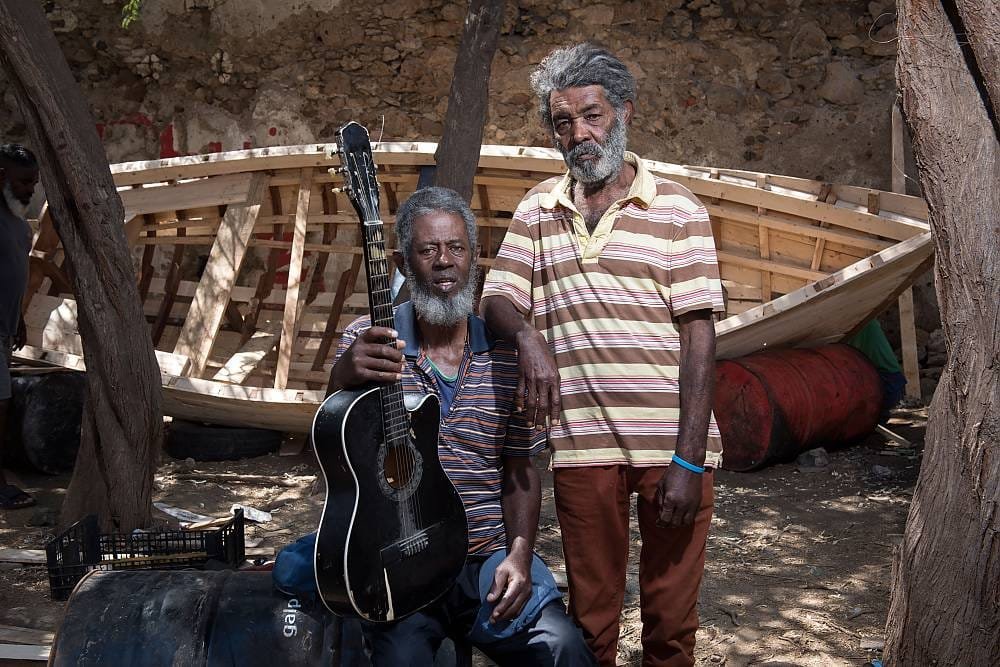
The Poetry of Sodade
As morna evolved, it became cherished as the music of longing. The Creole word sodade – derived from the Portuguese saudade – lies at the heart of morna’s most beloved songs. It’s expressing a profound sense of nostalgia and yearning that is often said to be untranslatable. Over the years, morna’s lyrics have explored themes of love and loss, of departure and return, of the sea’s separations and the homeland left behind. For Cape Verdean culture, shaped strongly by migrations and diaspora, these songs became a diary. Early mornings were occasionally sung in Portuguese. But gradually, Cape Verdean Creole (Kriolu) became the preferred language of expression. It’s the language in which the emotions of everyday folks could be most authentically conveyed. Singers often improvised verses, turning personal sorrows, devotion, or even wry humour into plaintive poetry set to music. Whether lamenting an absent lover, celebrating a reunion, or simply describing the moonlit beauty of an island night, a morna always carries a current of heartfelt emotion. Even in its simplicity, the genre’s emotional resonance runs deep; as Cape Verdeans say, morna is music to sofré (“suffer”) and to remember.
Evolution in the 20th Century
By the end of the 20th Century, morna had spread across the whole archipelago. Each island added its nuances to the genre. A pivotal figure of this era was Eugénio Tavares, a poet-composer born in 1867 on the island of Brava. Tavares became one of morna’s early creators and innovators. Infused it with a new romanticism and literary polish. Writing his lyrics in the flowing Brava Creole dialect, he penned mornas that elevated the art of the genre – love ballads and nostalgic hymns to the motherland that set the standard for generations to come. Tavares lived through an era of hardship and migration; after a devastating famine, he spent years in New Bedford, Massachusetts, as part of a Cape Verdean immigrant community drawn there by whaling and maritime trade. From exile, he wrote yearning verses of sodade for the home he left behind. Upon returning to Brava, Tavares’s elegant Creole mornas – often published as poetry in newspapers before being sung – helped define morna’s classic form: slow, sentimental, and filled with the ache of love and homesickness. Thanks to him and his contemporaries, by the 1920s, morna had firmly become the “music of the heart” for Cape Verdeans, its lyrics as crucial as its melody.
30s and 40s
In the 1930s and 1940s, morna underwent further refinement in the cultural crucible of Mindelo, the cosmopolitan port city on São Vicente Island. There, a younger generation of musicians, exposed to international sounds, added new layers to the traditional morna. Foremost among them was Francisco Xavier da Cruz, better known by his nickname B. Leza (or Beléza). A gifted composer and guitarist, B. Leza was heavily influenced by Brazilian popular music, such as samba and choro. He introduced what he called the meio-tom brasileiro, or “Brazilian half-step” – graceful passing chords that slipped in between the standard chord progressions of morna. This innovation enriched morna’s harmony, giving it a smoother, jazzier sophistication while retaining its soulful core. Under B. Leza’s influence, mid-century mornas became more harmoniously complex and lush. This period also coincided with a blossoming of Cape Verdean literature and arts (the Claridade movement), which encouraged artists to embrace Creole culture and address social themes. Morna lyrics accordingly widened beyond the purely romantic; some songs subtly praised the beauty of the islands or expressed the quiet hope of an oppressed people yearning for dignity and freedom.
50s, 60s, and 70s
Throughout the mid-20th Century, other musical genres emerged in Cabo Verde – upbeat styles such as coladeira and funaná – but morna remained the sentimental favourite. By the 1950s and ’60s, Cape Verdeans were migrating in large numbers to Europe and America, and they carried morna with them in their hearts and on their records. Radio broadcasts in the 1940s had already begun to spread morna across islands and into homes, making it a unifying cultural thread in a geographically fragmented country. Some modernisation did occur: electric guitars and drum kits were introduced to morna ensembles in the 1960s, and urban nightclubs brought the music to younger listeners. Yet even as Cape Verde hurtled toward independence in 1975, the essence of morna – its sweet sadness and familial warmth – remained unchanged.
In tavernas from Mindelo to Praia, one could still hear an acoustic guitar and violin accompanying a mournful Creole song late into the night. It was clear that morna was more than just music: it was the sound of Cabo Verde’s soul, an art form continually renewed by each generation.
The Queen of Morna: Cesária Évora
No one did more to share morna with the world than the late Cesária Évora, Cabo Verde’s most famous singer. Born in 1941 in Mindelo, Cesária (affectionately nicknamed “Cize”) grew up singing morna in local bars as a young woman, enchanting listeners with her velvety voice.
For decades, she was beloved at home yet virtually unknown abroad, surviving through hard times with occasional gigs and a resilient spirit. That changed in the late 1980s when, in her late forties, Évora recorded her first international albums and began touring overseas. Audiences around the globe were soon captivated by the melancholic beauty of her music. Her 1992 album, Miss Perfumado, featuring the haunting track “Sodade,” became a breakout success, introducing countless new listeners to the sounds of Cabo Verde.
Évora’s rich, sorrowful voice — often compared to that of a blues or jazz singer like Billie Holiday — conveyed the depth of emotion in morna, even to those who didn’t understand its Kriolu lyrics. Performing always with her trademark humility and bare feet (hence the moniker “Barefoot Diva”), she brought an authentic slice of island life to prestigious stages from Paris to Tokyo. In 2004, Cesária Évora won a Grammy Award for her album Voz d’Amor, confirming her status as the queen of morna on the international stage. More than just a celebrity, she became an icon for the Cape Verdean people, proof that a simple Creole song born of isolation and longing could touch the hearts of people worldwide.
From Cape Verde to the World
Évora’s worldwide fame opened doors for other Cape Verdean artists and ensured that morna would not fade with time. In her touring band and among her protégés were musicians dedicated to carrying the tradition forward. One of them, Tito Paris, a multi-instrumentalist and singer, moved from Cabo Verde to Lisbon and became a major ambassador of morna and other Cape Verdean styles in Europe. “I cannot step on stage without playing a morna,” Tito Paris likes to say, reflecting how the genre remains at the core of Cape Verdean musical identity. Younger singers, too, have embraced morna, sometimes blending it with jazz, pop, or other influences. The acclaimed Mayra Andrade, born in 1985, grew up listening to Cesária Évora and was even hailed by Évora as a potential successor. Andrade and others of her generation blend traditional morna with fresh elements, attracting young people while honouring its roots.
Meanwhile, veteran morna composers such as the late B. Leza have posthumous influence as new voices continually reinterpret their classic songs. From local taverns in Praia to concert halls in Lisbon and Rotterdam, morna has become a cherished part of the world music tapestry, revered both within and beyond Cabo Verde.
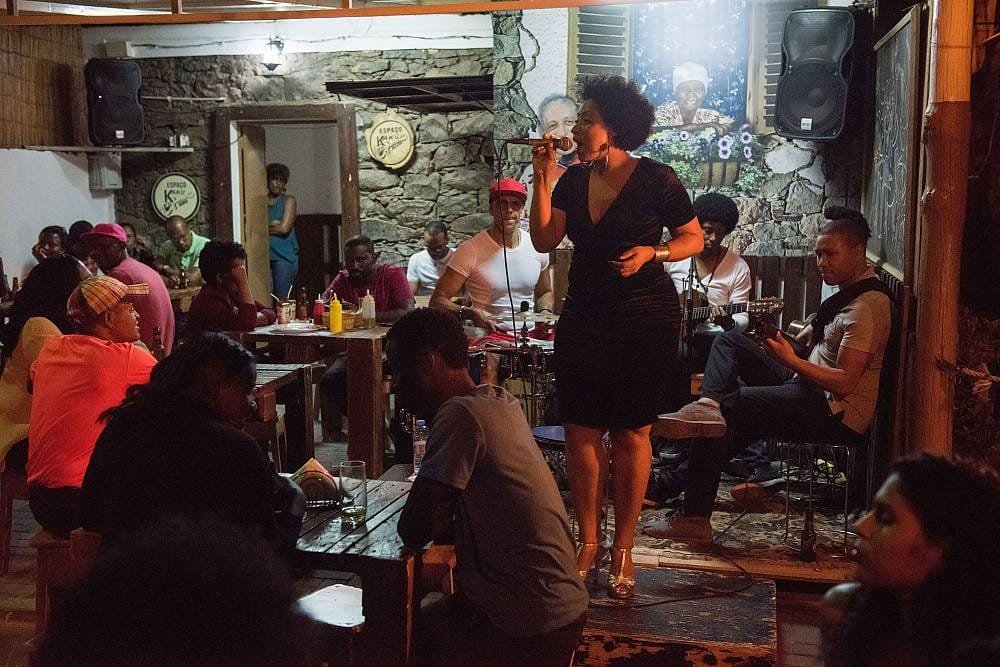
Legacy and Preservation
Veteran morna musicians, such as this violinist and guitarist, performing an acoustic morna, keep the tradition alive by mentoring younger generations. In December 2019, morna was officially inscribed on the UNESCO Representative List of the Intangible Cultural Heritage of Humanity. This international recognition affirmed what Cape Verdeans had long known: morna is not just entertainment but a cultural treasure — a living repository of Cabo Verde’s collective memory and identity.
At home, the Cape Verdean government and cultural organisations have stepped up efforts to preserve and promote morna. Some seasoned musicians have established music schools and community workshops to teach the subtleties of morna’s guitar techniques, poetic songwriting, and dance etiquette to the youth. Across the islands, festivals and competitions celebrate this heritage. For example, an annual event called “Todo Mundo Canta” (“Everybody Sings”) encourages young performers on each island to present morna songs, keeping the tradition fresh and vibrant.
Morna Nowadays
Though new musical fads come and go, morna continues to endure as the sentimental heart of Cabo Verde. It thrives not in neon-lit stadiums or on the top-40 charts, but in the intimate circles of family gatherings, at community cultural nights, and during informal tocatinas (impromptu jam sessions) where a guitarist might strike up a familiar morna and everyone joins in the chorus. In these moments, time seems to slow down to morna’s gentle sway.
The music carries listeners back in years, across vast oceans, uniting those at home and abroad in a shared feeling of sodade. From the windswept villages of Boa Vista to diaspora communities in Boston and Lisbon, morna remains a bond between Cape Verdeans and their roots. It is the melody of their history — the echoed strum of a guitar and the wistful refrain “sodade, sodade” — always calling them home.
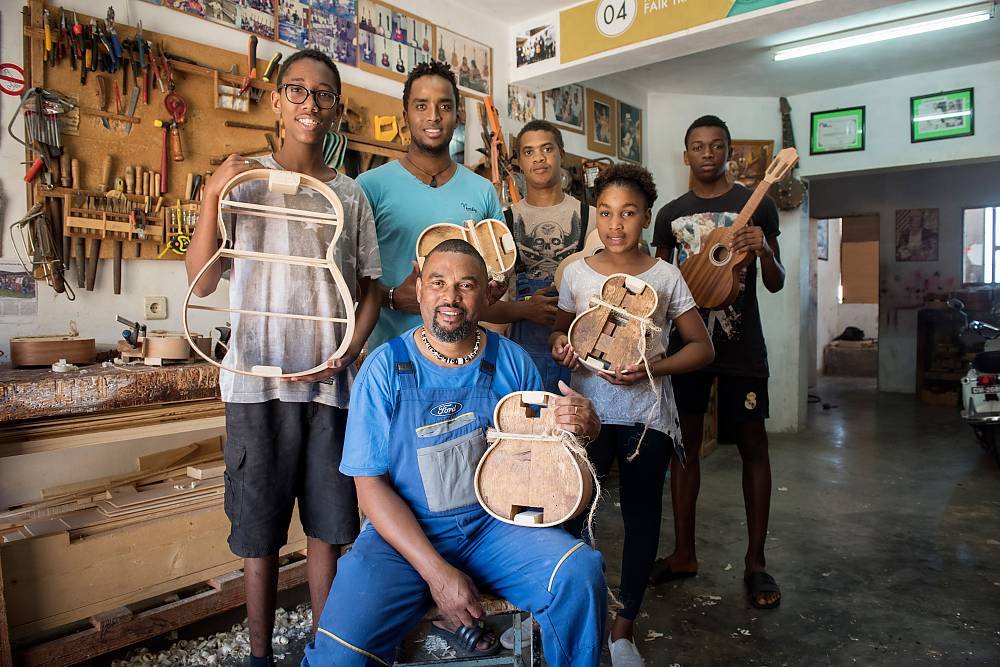
Bibliography:
- UNESCO Intangible Cultural Heritage – “Morna, musical practice of Cabo Verde” (Inscribed 2019);
- Beatriz Ramalho da Silva – “The story of morna: Cape Verde’s music of displacement and return”, Al Jazeera (Features, Music), 23 May 2021;
- Official Boa Vista Cabo Verde Website – “The Morna, the traditional musical genre of Cape Verde.”
- Morna (music) on Wikipedia, the Free Encyclopedia.
